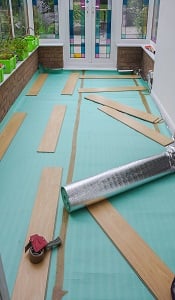
A homeowner only truly cares about the final layer of flooring, whether it be laminate, wood, or travertine. But a good builder knows what’s under that layer is where the important work is done. We often talk about subfloors, which are the foundation of lasting floors, but there’s a layer in the middle that we’ll focus on today. The underlayment, which is the layer that goes between the actual flooring and the subfloor, is a key component of a sound flooring structure.
Underlayment Material Choices
Underlayment is a general term, but there are actually several types depending on the situation and the kind of floor going on top. The most common materials are foam, rubber, cork or felt.
- For tile flooring - Tile underlayment needs to provide solid support to prevent cracking of tile and grout when walked on. However, there must also be flexibility to absorb movement, expansion, and contraction that comes with temperature and humidity fluctuations. For tile, there are two materials recommended. Two materials meet these requirements exceptionally well: Cement Board Underlayment (CBU), also known as cement backer board, and DITRA Uncoupling Membrane, a premium underlay.
- For wood flooring – Moisture and acoustics are major concerns. The type of wood, the geography, and the climate all need to be considered. There are many options for underlayment for hard wood, including felt, cork, rubber, and foam.
- For laminate flooring – Laminate is an affordable alternative to wood or tile that comes in a large array of styles. Some laminate will come with underlayment attached, making installation a breeze. For those that don’t, consider Acoustical Laminate Underlayment, generally made of cork or felt or Foam Laminate Underlayment, the most common choice.
Benefits of Using Underlayment
There are several benefits for using underlayment as part of the flooring.
- Increases support for the floor – Adding an underlayment makes the entire floor more stable
- Increases longevity of the floor – Adding more support and protecting the floor from friction will allow it to last longer and perform better
- Makes the flooring quieter – The underlayment muffles the sounds of footsteps and acts as an extra sound barrier
- Helps to repel moisture – For parts of the country that deal with water and humidity often, this will help
- Prevents movement of the layers – As temperature changes, keeps the flooring system together
- Makes the floor softer – Especially when putting in carpet, this gives an extra layer of cushioning
As you can see, there are many benefits of applying underlayment. When deciding the right underlayment material for your job, think about the specific benefits you want the underlayment to provide. What type of surface are you applying it to and what type of flooring are you installing on top of?
Of course, the underlayment is only a part of the entire system. For best results each layer of the floor structure needs to be installed properly using quality tools and techniques. The underlayment needs to be kept pristine with no dents, bumps, edges or fasteners that might be able to penetrate the flooring layer above. Also make sure to only install underlayment to a dry subfloor, because moisture in the subflooring could cause issues.
When installing your subfloor, consider using BECK's SCRAIL® SubLoc® Pro, a system designed especially for building squeak-free floors. The fasteners used in this system have a patent pending Diamond Coating for vastly improved holding power. Easily driven in with the pneumatic tool, these fasteners offer the same unique advantage as all the other SCRAIL® fasteners – removal is as easy as installation if adjustments are necessary.
Using the best quality fasteners and tools, like SCRAIL® SubLoc® PRO and pneumatic tools from BECK America, will ensure every layer of your flooring is built to last.
.svg.png)

